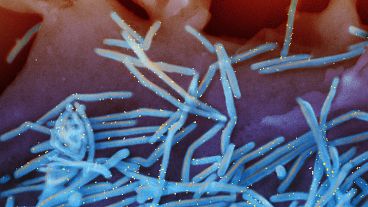Zebrafish brains share a number of characteristics with those of humans, which is why they’re being used to track the movement of cancer cells in real time.
In recent years, cheap, easy to breed zebrafish have become an important ally for cancer researchers.
At the Institut Pasteur in Paris, a number of teams are studying the fish’s brain which has similar characteristics to those of humans.
In a kind of fish farm located in the basement if the French research institute, research engineer Sébastien Bédu uses a sieve to collect eggs that have been laid by this little fish.
He then takes a needle and injects a DNA fragment containing a gene which he wants to analyse into it.
Advantages of using zebrafish
The process is “much easier than using mice because it doesn’t require any surgery,” he explained.
And while they’re not yet as widely used as lab mice, the zebrafish has become an important organism for scientists looking to replicate the physiological characteristics of humans.
Some 70 per cent of human genes have an equivalent in the zebrafish genome.
The second advantage that the zebrafish has is its small size which allows the researchers to breed large numbers of them in small volumes of water.
“When they reproduce, they lay a lot of eggs, they are easy to manage and they’re much cheaper than rodents. They’re a researcher’s dream model,” said Bédu.
On top of that, while the stripes for which the fish is named develop when it is an adult, in the early stage of its development, the fish larva is totally transparent. It means that researchers are able to observe various biological phenomena in the organism using only a microscope.
“In this living animal, we can track cells: how they move; how they divide; how they die - without any invasive procedure,” Laure Bally-Cuif, Director of the Developmental Biology and Stem Cell Department at the Institut Pasteur, explained.
Of particular interest to the institute’s researchers is the nervous system stem cells of the vertebrate.
“There are lots of these cells in the adult brain of this fish, which is rarely the case in mammals,” Bally-Cuif explained amid the rows of aquariums.
Stem cells are essential to brain plasticity because of the neurons they generate but they can also cause disease when they malfunction.
"By studying these cells, we hope to better understand how they function normally, and eventually find ways to correct them when they malfunction, or activate them to produce more neurons," said Bally-Cuif.
Cure for leading cause of cancer in children
It is hoped that the zebrafish brain will help researchers better understand the development of glioblastoma, a rare but highly aggressive brain tumour that still has no cure.
“What we’re trying to find out is how to block cancer cell migration,” Sandrine Etienne-Manneville, head of cell polarity, migration and cancer at the Institut Pasteur. said.
“To do this, we need to first understand how they migrate,” she added.
Scientists here take tumour cells from patients with this cancer and inject them with fluorescent colouring.
These are then injected into the brains of transparent zebrafish larvae whose blood vessels or neurons are coloured by genetic manipulation. This makes it possible to track the movement of cancer cells inside the fish’s brains in real time.
"We can observe in vivo, within the brain tissue, whether these cells have significant invasive properties, and how and where they migrate, which will help improve diagnosis in patients with this cancer," said Etienne-Manneville.
The ultimate goal is to be able to develop a treatment for this kind of tumour which is the most common paediatric cancer in France and the leading cause of cancer-related death in children.
For more on this story, watch the video in the media player above.



